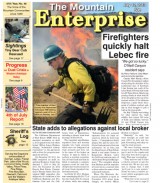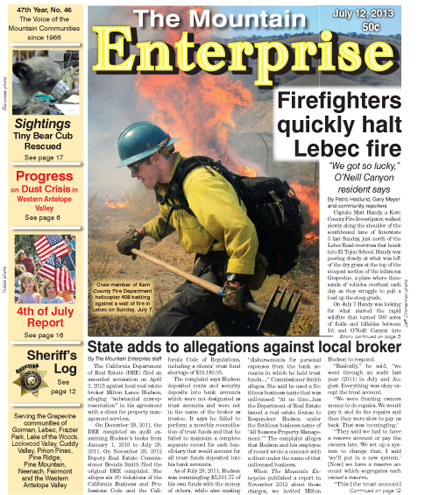By Patric Hedlund, Editor
It may have taken two years of activism on the part of concerned neighbors and town councils, but the good news is that a foundation may now be in place for progress toward solving the Western Antelope Valley “fugitive dust” crisis. Respiratory problems, risk of exposure to blowing Valley Fever spores and traffic hazards caused by blinding dust storms along Highway 138 have all mobilized community action.
Robert Kerekes, president of the original Antelope Acres Town Council, has produced a study of the problem of fugitive dust in his area, illustrated with his own photographs. Richard Skaggs and Gerard Conroy, president and vice president of the Neenach-area Oso Town Council, have long proposed decomposed granite as a mitigation during construction rather than the ineffective water treatment used by contractor First Solar, Inc. in its grading work to construct both NRG’s Alpine Solar and Exelon’s Antelope Valley Solar Ranch One.
In 2012, the Oso Town Council sent three of their representatives to Washington D.C. to speak with the staff of Congressman Kevin McCarhty about the problem and its link to Valley Fever. Last year Fairmont Town Council President Barbara Rogers and her husband revealed that he had been diagnosed with the disease, and was receiving treatment for Valley Fever.
This May 2013, I too visited Washington D.C. to interview Congressman Kevin McCarthy directly for The Mountain Enterprise. I showed him photos of the dust storms and asked what he thought could be done to hold solar utility developers—many receiving federal loan guarantees—more accountable for effective dust mitigation. We discussed the link between blowing dust in construction zones and the rising risk of Valley Fever for his constituents.
It appears May 2013 was a very good month for action on fugitive dust in the Antelope Valley. Los Angeles County Supervisor Michael D. Antonovich introduced a motion on the subject to his colleagues on the board of supervisors.
Antonovich Field Deputy Norm Hickling confirms that the supervisors unanimously endorsed the motion to instruct directors of L.A. County “Planning, Public Works and Public Health to explore possible county code amendments and require the following from all solar energy facilities in Los Angeles County:
“1. An alternative construction method to mass grading, disking and scraping where solar panel arrays are to be located; and
“2. That any grading, disking and scraping to access roads, walkways, required basins and berms be permanently stabilized with an earth stabilizing product that is acceptable to the Departments of Planning, Public Works and Public Health to prevent fugitive dust.”
Norm Hickling cautions that the sources of fugitive dust are not confined only to construction of solar facilities. He mentions fallow farm fields, agricultural grading, plowing and other forms of construction in the region. But he is confident, he says, that “this got the notice of all the solar companies. All the companies now recognize they have a responsibility to the community to take appropriate actions to not have dust coming off of their facilities. it is a major concern in this region. It is highlighted that the board is united in this matter too. We will be very aggressive to see that these matters are addressed.”
This is part of the July 12, 2013 online edition of The Mountain Enterprise.
Have an opinion on this matter? We'd like to hear from you.


